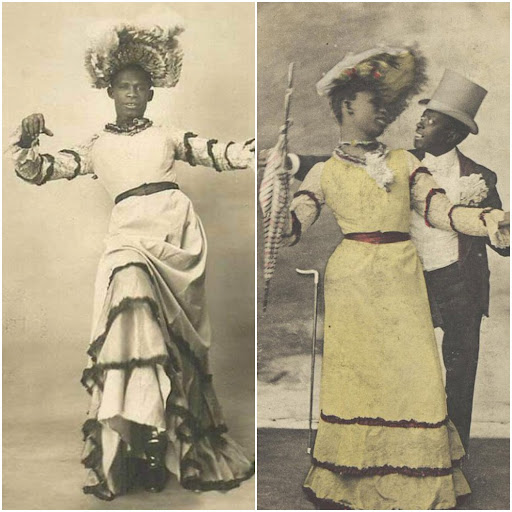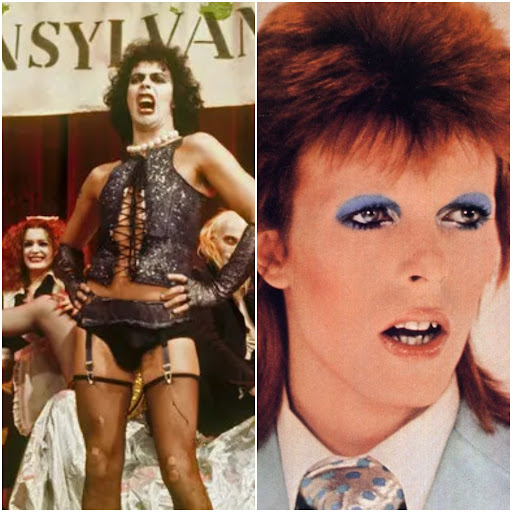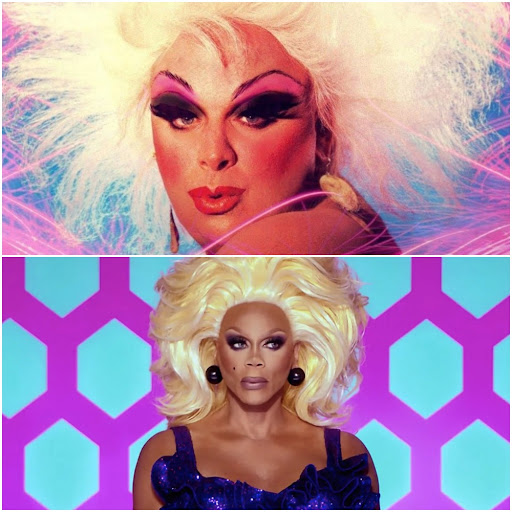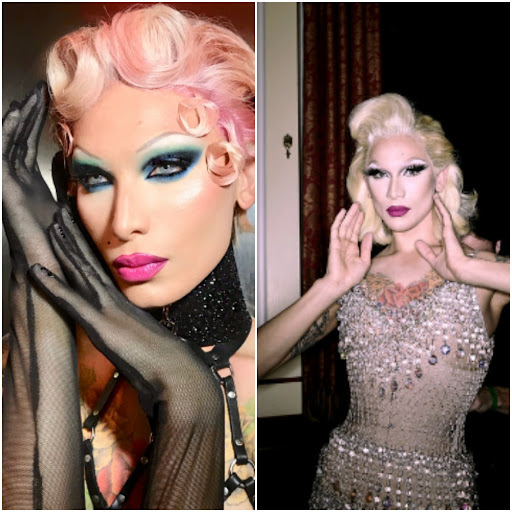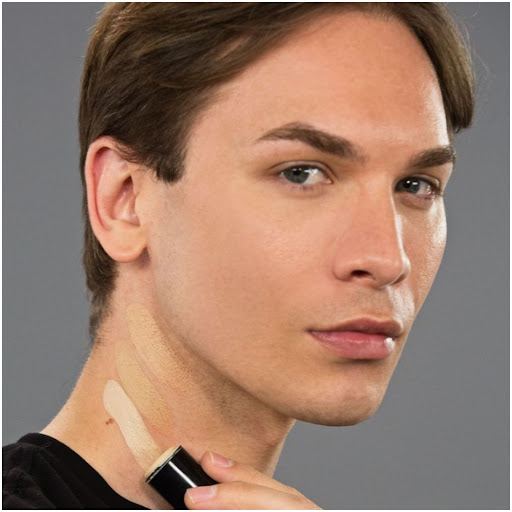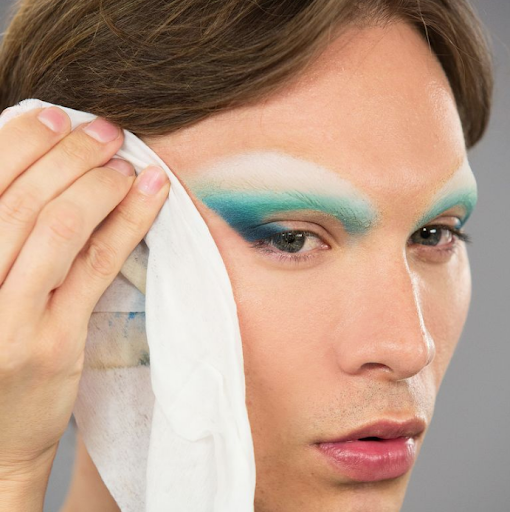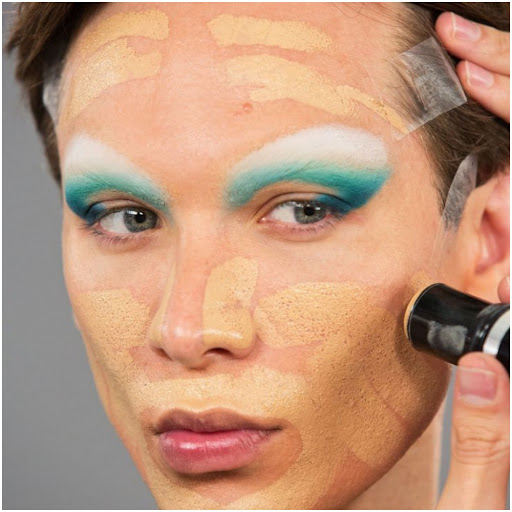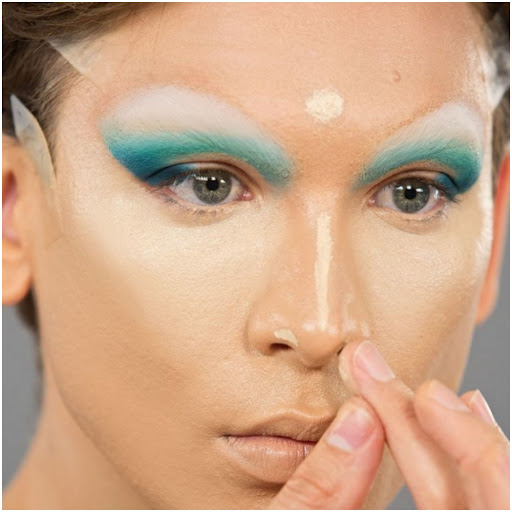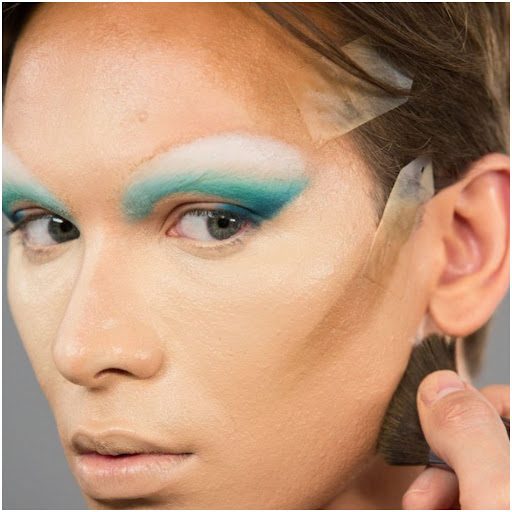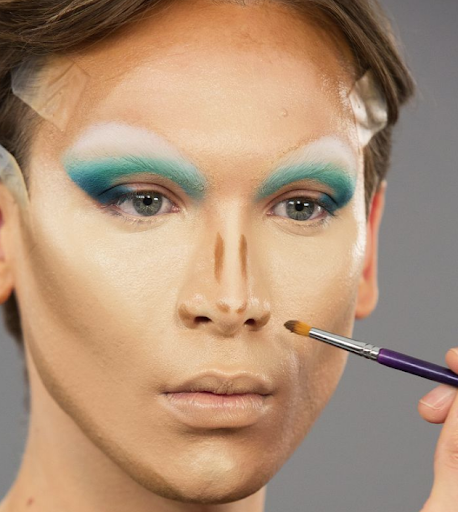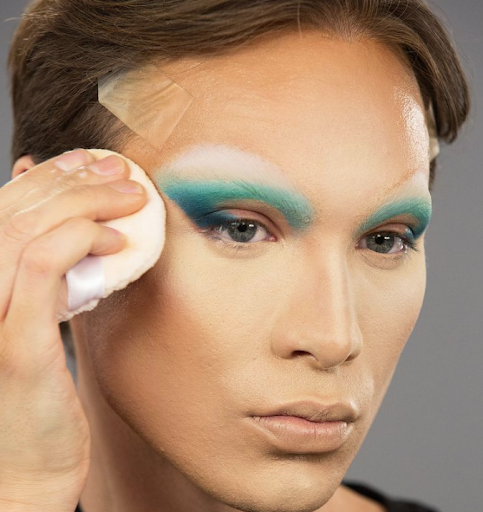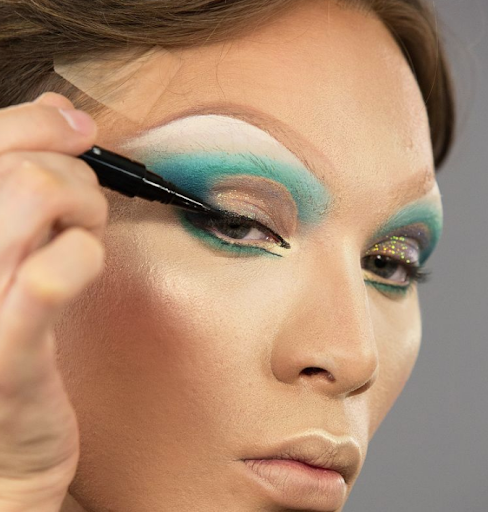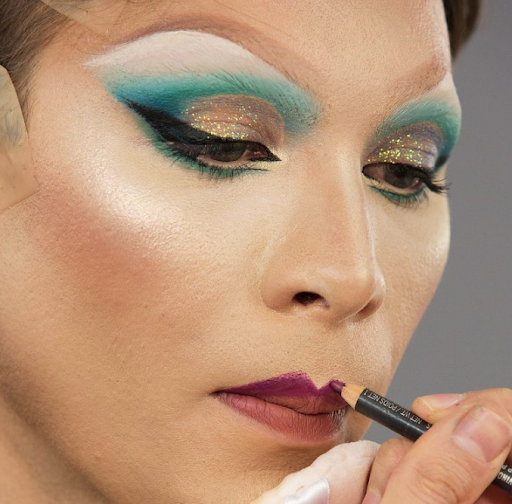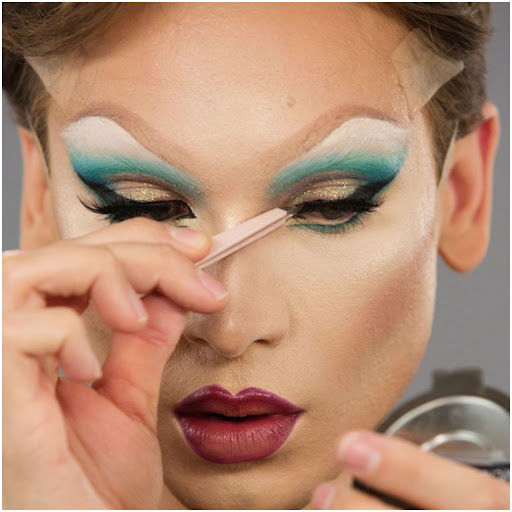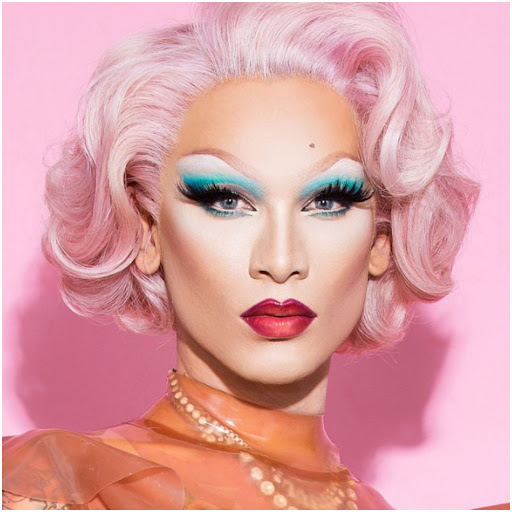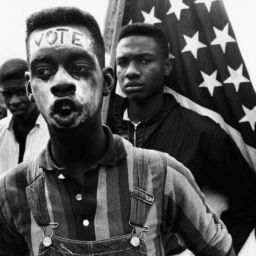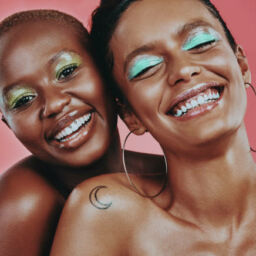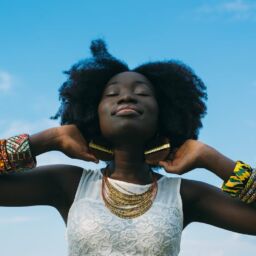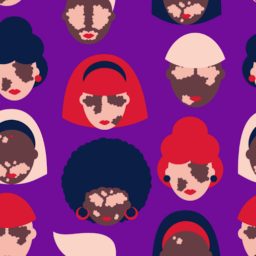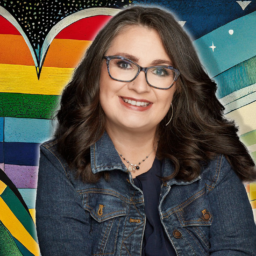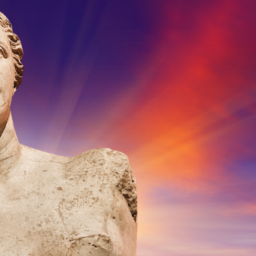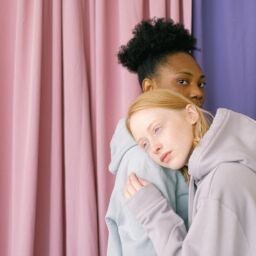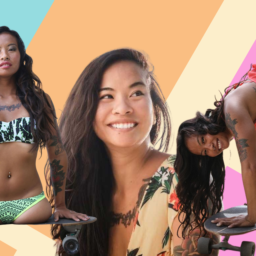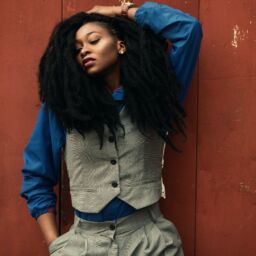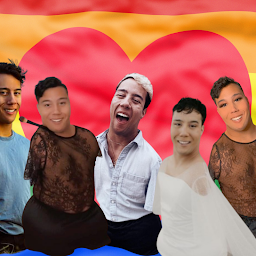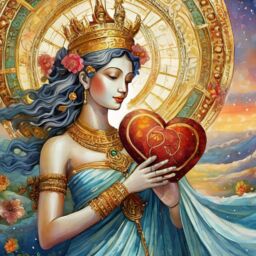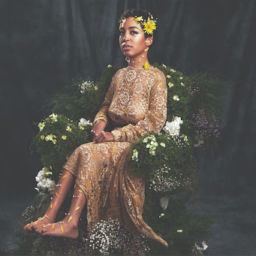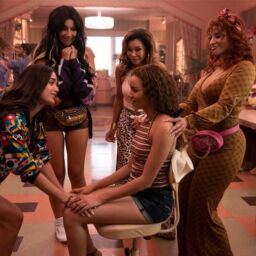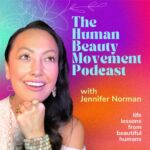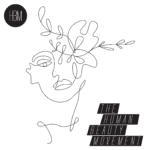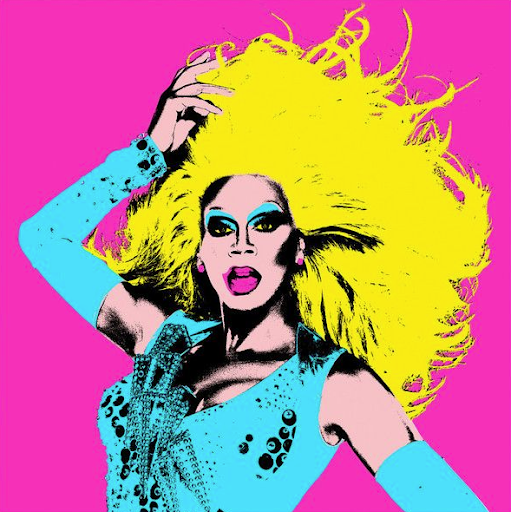
“We’re all born naked and the rest is drag.” — RuPaul
If you look up “cut crease tutorial,” you’ll see countless beauty vloggers giving tips and tricks on how to achieve the dramatically precise eye look. Chances are you’ve also seen a few ombré block eyebrow videos and some fluttering false eyelash application hacks.
Seeing people of all genders apply glitzy stage makeup has become a mesmerizing new form of entertainment, where donning heavily contoured cheeks, blinding highlighter, and pouty lips is central to the look. While some regard it as “Instagram makeup,” it’s really decades of quiet, but powerful, influence from the drag community.
Before YouTube, TikTok, Instagram, and influencers, makeup techniques like baking and contouring were used by drag queens in the dressing rooms of clubs. They were passed on by word of mouth, taught by peers, or older performers who’d take newcomers under their wings.
Borrowing from theater tradition, drag makeup was about exaggerating features so the performer wouldn’t be washed out under bright stage lights, and their expressions could be seen by someone sitting in the back of the room.
Like creating glam costumes, dancing, and lip-syncing, knowing how to do makeup was just one of the many skills it took to be a successful drag queen. But, makeup is more than just a means to an end; it’s a tool of transformation, and for many queens, liberation.
A Step Back In Time
When you Google the definition of drag, you will likely come across the name Joe E. Jeffreys. He is a drag historian and professor of theater studies at New York University who tells us that drag is “clothing more conventionally worn by the opposite sex, especially women’s clothes worn by a man.”
By that definition, drag can be traced back to ancient religious and spiritual occasions from Native Americans, Indigenous South Americans, Egyptians, and the Japanese. In Japanese theater, for example, men dressed in feminine clothing for folk dances, and in Shakespearian theater, they commonly portrayed female characters with fancy makeup and dress.
The term “drag” originated in Britain and was first used as a subset of English theater slang in the 1870s to refer to the long skirts that men wore on stage that dragged the floor. Men continued to wear exaggerated makeup and clothing to play female roles until it finally became legal for women to perform in 1660.
Female parts played by men due to a lack of female actresses isn’t exactly in the spirit of what we call drag today – but it was a start. It soon became a way for men to express a different side of themselves: over-exaggerating feminine looks, style, and body language to create a new persona.
In the 1880s, men started impersonating females and performing in vaudeville shows, a type of entertainment featuring speciality acts like burlesque comedy and song and dance. William Dorsey Swann, the first person to call himself a “queen of drag,” began to host drag balls during this time, as well.
Pictured: William Dorsey Swann Source: World Queer Story (Left), Medium (Right)
Drag wasn’t linked with homosexuality until sexology developed ideas about a third sex in an attempt to rationalize why it existed. According to Jeffreys, “The third sex was discussed as a feminine man or a masculine woman who desires members of the same sex. By the 1930s, this scientific conversation had worked its way into the popular culture and linked drag with homosexuality.”
As a result, drag became widely shunned with Masquerade Laws punishing those who “cross-dressed” in public. In addition, gay bars had to operate underground, though they were constantly raided by police, which continued until the Stonewall Riots in 1969 when patrons in New York City fought back against the authorities.
The first Gay Pride Parade was held a year later, leading to gradual acceptance for the LGBTQ+ community. Though drag queens and transgender individuals were still marginalized more than their queer peers, drag icons began to emerge.
Hollywood Icons Paved The Way
Drag culture slowly began to re-enter mainstream society in the 1970s. Signs of the acceptance of drag can be seen in films like Rocky Horror Picture Show in 1975 and in musical performances like that of David Bowie with his dramatic, drag-esque style.
Pictured: Left: Tim Curry in Rocky Horror Picture Show (Static 01); Right: David Bowie (Image)
Divine, named People Magazine’s “Drag Queen of the Century,” inspired the design of Ursula in Disney’s The Little Mermaid. Paris is Burning, a popular seven-year documentary about drag balls in New York City, and The Birdcage, a comedy about a gay couple who run a drag cabaret, also shifted attention to drag and helped it grow in American culture.
RuPaul Charles has become one of the most well-known drag queens in the world. Her 1993 song, “Supermodel (You Better Work),” launched the success of her performance career, and her competitive reality show RuPaul’s Drag Race, which premiered in 2009, created a platform for other performers to feel included.
The once-niche reality competition show combined the best elements of America’s Next Top Model and Project Runway and gave an unprecedented platform for the drag community. Fourteen seasons and a couple of Emmy Awards later, it’s catapulted many of its 126 contestants’ careers to immense heights.
Today, drag queens are touted as experts in all things makeup and fashion. They mesmerize millions of audiences with their skills and dramatic transformations, shining brightly against a dark backdrop of history that finally embraces them.
Pictured: Top: Divine (Pink News), Bottom: RuPaul (Media Them)
Makeup Hacks From Drag Queen Miss Fame
Pictured: Miss Fame Source: The Photo Studio
RuPaul’s Drag Race is a huge milestone in drag history. If you’ve tuned into the show, chances are you recognize Kurtis Dam-Mikkelsen, aka Miss Fame, from season seven.
If you haven’t seen season seven, allow me to give you the rundown: Kurtis is a 32-year-old guy that grew up on a farm in a small town called Templeton, California, where he tended to cows and chickens.
“Vanna White was the only beauty reference I had, aside from my four aunts,” Kurtis explained to Cosmopolitan. “They all had Brooke Shields brows, shimmer shadow from their lashes up, and ’80s bangs, and I loved admiring them — they didn’t even know how pretty they were because we were so confined to our farm and our small town.”
Inspired by his aunts’ beauty and fueled by his natural talent for drawing, Kurtis enrolled in beauty school after high school, which eventually led to him becoming a hairstylist, makeup artist, model, spokesmodel for L’Oréal Paris, and world-renowned drag queen aliased with the name Miss Fame.
Miss Fame is beyond amazing when it comes to makeup; he really knows his stuff. Thankfully, he’s blessed us with transparency by teaching his amazing drag makeup hacks that you can use when applying a full face.
The shade that best suits your skin tone should always be your base color, but the one that’s a touch too dark could double as your contour, while the one that’s too light can be used as a highlighter.
Figuring out your correct foundation shade before applying any base is key. However, Miss Fame suggests always starting with your eye look first to keep eyeshadow fallout from ruining your flawless foundation application.
Source: Cosmopolitan
Makeup wipes are heaven-sent when it comes to precise lines. After all, no matter how good you are at doing your makeup or how much you practice a certain eye look, you still might not nail a straight line on the first try, which is perfectly okay and normal.
Miss Fame uses makeup wipes to buff away any imperfections and to create a straight edge in a snap. Simply swipe the side of a wipe along the outer corner of a cat-eye or graphic shadow shape for a sharp line every single time.
Source: Cosmopolitan
Use a foundation that matches your exact skin color on the perimeter of your face: your jawline, cheeks, outer edges of your forehead, and along the sides of your neck. Next, swipe a lighter foundation under your eyes, on the middle of your forehead, on the center of your chin, down your nose, around your nostrils, and on the inner part of your neck. Then, blend everything with a damp makeup sponge, pressing the makeup into your skin for a more natural finish.
Source: Cosmopolitan
According to Miss Fame, applying concealer a shade lighter than your skin color under your eyes, down the center of your nose, on the indents of your nostrils, on your chin, and a dab in the center of your forehead can bring forward the features you want to showcase and refine.
Source: Cosmopolitan
To make sure your contour looks believable, try holding the head of a dense angled brush while applying a deeper foundation or bronzer to your skin, avoiding harsh lines. This keeps your contour soft and diffused, rather than thick and heavy, which can age a face quickly.
For proper placement, try sweeping the brush along your hairline, under your cheekbones, along your jawline, and under your bottom lip; then blend with a damp makeup sponge. These placements can minimize the width of the face. Plus, placing a shadow under the bottom lip is known to add instant volume.
Source: Cosmopolitan
With a thin lip brush or paintbrush— and a foundation that’s two shades darker than your actual skin tone— contour the high bridge of your nose, and then add a dash at the tip of your nose on both sides at upward angles. This can make your nose look slimmer. Next, lightly blend with a makeup sponge, while being careful not to over diffuse your contour.
Source: Cosmopolitan
If you have dark circles and your concealer tends to settle in the creases under your eyes, you can set your concealer with tinted powder that matches your skin tone using a fluffy brush to create a super-even, dark circle-free effect. After, add a little more powder to the puff and press it into your skin to prevent creasing.
Source: Cosmopolitan
Whether you’re creating a cat-eye or not, trace your top lash line, extending the liner past the inner corner of your eye. This not only elongates your eyes, making them appear bigger, it can also add femininity to the eye and more drama.
Source: Cosmopolitan
To create a slightly larger lip shape, draw two triangles over the peaks of your upper lip, and then round them out perfectly with a flat-tip brush to reveal your new lip shape. This technique can make your lip look appear more believable.
Source: Cosmopolitan
Leaving the ends of your false lash strip free of glue can make your lashes appear more real. You want your lash strip to be anchored on your lash line, starting at your iris and a little past the center of your lid.
Doing this can create the look of an elevated, elongated eye line. And before you worry that you’ll lose a lash or two throughout the day, making sure the lash glue is slightly tacky when you adhere it to your upper lash line will keep them perfectly in place.
Source: Cosmopolitan
You can view all of Miss Fame’s makeup tricks in action by clicking here. But first, let’s all appreciate all of these tips, tricks, and hacks put together because Miss Fame is slaying it.
Source: Cosmopolitan
Drag Makeup Is Here To Stay
“When you become the image of your own imagination, it’s the most powerful thing you could ever do.” — RuPaul
Drag began as men donning dresses and makeup in ancient practices and theater programs, but it’s evolved to become a nuanced and unique culture. Drag makeup, for example, is becoming the sought after look that everyone searches tutorials and hacks to achieve; it’s beautiful, artistic, and dramatic.
Roots from the drag community have grown into a fully bloomed tree of beauty, acceptance, and genuine expression. Drag culture is flourishing today with queens embracing themselves and their history. With television and the internet, they’re allowing us to become informed on their extraordinarily beautiful lives and inviting us to participate in their evolution. And for this, we are forever grateful.

